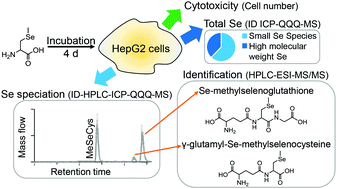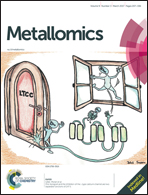Tracing cytotoxic effects of small organic Se species in human liver cells back to total cellular Se and Se metabolites†
Abstract
Small selenium (Se) species play a major role in the metabolism, excretion and dietary supply of the essential trace element selenium. Human cells provide a valuable tool for investigating currently unresolved issues on the cellular mechanisms of Se toxicity and metabolism. In this study, we developed two isotope dilution inductively coupled plasma tandem-mass spectrometry based methods and applied them to human hepatoma cells (HepG2) in order to quantitatively elucidate total cellular Se concentrations and cellular Se species transformations in relation to the cytotoxic effects of four small organic Se species. Species- and incubation time-dependent results were obtained: the two major urinary excretion metabolites trimethylselenonium (TMSe) and methyl-2-acetamido-2-deoxy-1-seleno-β-D-galactopyranoside (SeSugar 1) were taken up by the HepG2 cells in an unmodified manner and did not considerably contribute to the Se pool. In contrast, Se-methylselenocysteine (MeSeCys) and selenomethionine (SeMet) were taken up in higher amounts, they were largely incorporated by the cells (most likely into proteins) and metabolized to other small Se species. Two new metabolites of MeSeCys, namely γ-glutamyl-Se-methylselenocysteine and Se-methylselenoglutathione, were identified by means of HPLC-electrospray-ionization-Orbitrap-MS. They are certainly involved in the (de-)toxification modes of Se metabolism and require further investigation.



 Please wait while we load your content...
Please wait while we load your content...